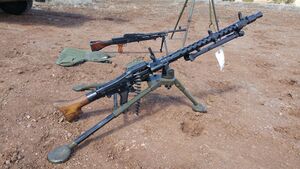MG36 GPMG
This article is incomplete because it is pending further input from participants, or it is a work-in-progress by one author. Please comment on this article's talk page to share your input, comments and questions. Note: To contribute to this article, you may need to seek help from the author(s) of this page. |
| Machinengewehr 36 General Purpose Machine Gun | |
|---|---|
 An MG36 with the Lucian Brnfield LMG on the foreground. | |
| Type | General-purpose machine gun |
| Place of origin | Erebonian Empire |
| Service history | |
| In service | 1936 - Present |
| Used by | See Users |
| Wars | |
| Production history | |
| Designer | Wolfgang Theimer Arnold Messerheim |
| Designed | 1950 |
| Manufacturer | Theimer Works Rainford Group |
| Produced | 1958–present |
| No. built | 1,750,000 |
| Variants | See Variants |
| Specifications | |
| Weight | 11.8 kg (26.01 lb) |
| Length | 1,219 mm (48.0 in) |
| Barrel length | 630 mm (24.8 in) |
| Cartridge | .30-06 Theimer 7.62x51mm GAL |
| Action | Open bolt, Recoil-operated, Rotating bolt |
| Rate of fire | 650–1,000 rounds/min |
| Muzzle velocity | 765 m/s (2,510 ft/s) |
| Effective firing range | 200–2,000 m (219–2,187 yd) sight adjustments 3,500 m (3,828 yd) with tripod and telescopic sight |
| Maximum firing range | 4,700 m (5,140 yd) |
| Feed system | 50/250-round belt, 50-round drum, or 75-round drum magazine with modification |
| Sights | Iron sights, antiaircraft sight or telescopic sights |
The MG36 GPMG is an Erebonian 7.62 mm recoil-operated air-cooled machine gun, designed jointly in 1930 by Wolfgang Theimer and Arnold Messerheim. It was tested in 1933 and was approved for service in 1934. At the time of its issue in 1936, the MG36 was arguably considered to be the world's most advanced machine gun. It introduced a new concept in machine gun technology, called the Universal Machine Gun or UMG and was considered to be the first General Purpose Machine Gun.
The MG36 was initially chambered in the .30-06 Theimer until it was standardised in 1950, re-chambering it into the 7.62x51mm GAL. The MG 36 was envisioned to provide portable light and medium machine gun infantry cover, anti-aircraft coverage, and even sniping ability. It had a high rate of fire of 900 rounds per minute and was unmatched. As a result, the experience of Imperial forces against the MG36 prompted the development of the Krimm MG42, which was a cheaper version of the MG36 but provided a higher rate of fire of 1200 rounds per minute.
Although it was considered to be light enough to be carried by one man, the reload took longer being that it was belt-fed, as a result, 50 and 75-round drum magazines were developed. But this still proved unsatisfactory. The MG36 did not fit the qualification of a squad support weapon, hence the Brnfield LMG or the TM18 Automatic Rifle remained as the standard squad infantry weapon, while the MG36 took up the role as a deployable company machine gun.
History
Development
Combat Service
Users
![]() Alteria
Alteria
![]() Altissia
Altissia
![]() Basel-Ebel
Basel-Ebel
![]() Esthar and Balamb
Esthar and Balamb
![]() Erebonian Empire: Standard Issue
Erebonian Empire: Standard Issue
![]() Gallia-Bruhl
Gallia-Bruhl
![]() Jutland-Gimli
Jutland-Gimli
![]() Lestallum
Lestallum
![]() New Akiba
New Akiba
![]() Nibelheim-Saxe-Hanover
Nibelheim-Saxe-Hanover
![]() Nihhon-koku
Nihhon-koku
![]() Rubrum
Rubrum
![]() Taoyuan
Taoyuan
![]() Tenebrae and Solheim
Tenebrae and Solheim
![]() United Kingdom
United Kingdom
![]() Zanarkand
Zanarkand